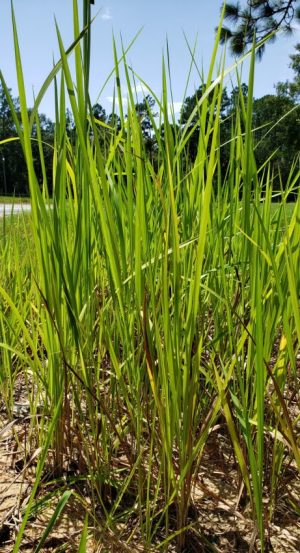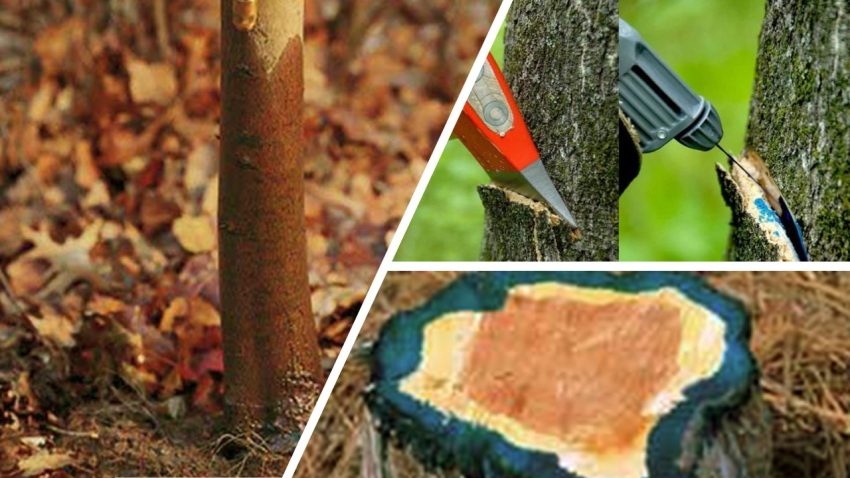Fall is here – peanuts are being picked and football season is in full swing. With fall being synonymous with the end of the growing season, it is a surprisingly good time of year to start many vegetation management operations around the farm or ranch. Fall is a particularly good time of year to chemically control unwanted perennial vegetation.
–
General Comments & Caveats
I know plants can’t read calendars and to my knowledge they don’t watch football, so how would they even “know” it’s fall? Why does the season matter? In very general terms, perennial plants (those that live for many years) respond to shortening day length; the decreasing amount of sunlight stimulates the plants to begin storing more energy for the winter ahead. This process increases the downward flow (from leaves, towards roots and rhizomes, etc.) inside the plant. This phenomenon pairs very well with how systemic herbicides need to move within the plant to be effective. Put another way, again in very simplified terms, fall applications of systemic herbicides to perennial plants build on the plants’ natural processes associated with transitioning to winter dormancy and provide the herbicide with excellent access and opportunity to affect the plant.
While fall can be an excellent time to control perennial vegetation, taking advantage of this opportunity does require some additional attention to detail, as compared to mid-summer herbicide applications. For herbicides to work properly the chemical must be able to enter the plant and the plant must then be able to move herbicide though its xylem and phloem cells.
- In the fall it is not uncommon for it to become very dry. Drought stress can impede both necessary processes described above. Fall herbicide applications only work when adequate moisture is available.
– - Foliar herbicides, like glyphosate, must enter a plant through a functional green leaf. At some point in the fall, the leaves of deciduous plants lose their functionality and thus their ability to convey herbicide to the rest of the plant. Chinese Tallow (popcorn tree) comes to mind here – if the leaves have changed color, they have been cut off from the rest of the plant making them useless for receiving herbicide.
– - Cold temperatures (particularly below freezing) can cause plants to go dormant. Dormant plants do not circulate herbicide effectively. Plants vary greatly as to what temperature induces dormancy and how quickly they regain functionality after temperatures increase. When controlling perennial grasses, it is generally recommended to make fall applications before first frost and the browning of leaves that closely follows. For plants that retain green leaves after frost (privet, for example), make sure temperatures are well above freezing at the time of herbicide application.

NOW is the time to treat cogongrass – fall, with good soil moisture. Don’t miss this ideal window for herbicide application.
Photo Credit: Mark Mauldin
–
Specific Vegetation Management Practices to Consider this Fall
- Kill Cogongrass. Almost every year, about this time I write an article reminding folks that now is the best time of year to kill cogongrass. I won’t rewrite the article this year, I’ll just include links to previous iterations – see below. Cogongrass is bad, if it’s on your property kill it now. In my opinion, it is the most troublesome weed we have here in Northwest Florida. It is very difficult to control; so, you need to do everything you can to improve your chances of success. Spraying in the fall (not mid-summer) really helps.
–
- Renovate and/or Establish a Pasture. At some point it can become necessary to completely start over with a pasture. This is generally the result of weedy grass encroachment – often a symptom of poor fertility and/or grazing management (that’s an article for another day). When the time for renovation comes, fall is the best season to start the process. Kill out all existing vegetation with herbicide (most problematic weedy grasses are perennials, see previous comments), till the soil, then plant cool-season forages on the prepared seedbed. In the spring, after the cool-season forages have played out, you can spray again to ensure total control of weedy grasses and then replant the perennial forage of your choice. Two shots of herbicide, plus tillage does a great job of getting your new pasture off to a clean start. This process is not exclusive to pasture renovations. I recommend the same process when establishing a pasture on “new ground” – or anywhere there is considerable competition from perennial weeds (broadleaf or grasses). Pasture establishment or renovation is a long, complicated, and expensive process. If you are not very familiar with all the steps involved, I encourage you to contact your local UF/IFAS Extension office for advice.
–
- Spray Blackberry. While not as involved as the previous two examples, I would be remiss to discuss fall vegetation management without mentioning blackberry. Blackberry can be a tough perennial weed to manage in bahiagrass pastures, where triclopyr based herbicide products are the go-to choice. In this scenario, we see the best results from triclopyr when it is sprayed in the fall on blackberries that have not been mowed for at least six months prior to spraying. More details on controlling blackberry can be found in the document linked below.
–
–
- Selectively Control Trees and Brush. Fall and winter are excellent times of year to employ several different methods which allow you to apply herbicide directly to induvial woody plants with relatively little risk to surrounding desirable vegetation. While very effective, all these individual plant techniques are quite labor intensive, making the cooler temperatures associated with the fall perhaps more important to the applicator than the plant physiology and herbicide efficacy discussed earlier. Use these links to access videos that discuss each technique in detail.
–
Note: Foliar applications (to the leaves) of herbicide to small trees and woody brush can be very effective in the fall, for the reasons mentioned earlier and provided all of the caveats mentioned earlier are accounted for. That said, foliar applications have their limitations and generally shouldn’t be used on trees over 8ft tall. Foliar applications also generally carry more risk of damage to surrounding desirable vegetation.

During the fall and winter trees and woody brush can be controlled via a variety of highly selective techniques, including basal bark, hack-and-squirt, and cut stump treatments. Image Credit: IFAS CAIP
–
- Mow??? I very infrequently recommend mowing for weed control but if weeds have not already made seed (many already have), fall mowing can clean up pastures and other open spaces while helping to lessen the seed bank available for next year’s crop of weeds. Dogfennel comes to mind as a weed that makes a tremendous amount of seed very late in the year, meaning there may still be time to mow them prior to their setting seed. Keep in mind that most perennial plants can and will recover after being mowed, so mowing them after they have made seed provides little lasting benefit. Along the same lines, annual plants naturally die after making seed making timing very important to providing any meaningful weed management. To further complicate matters, in the Panhandle some dogfennel can’t decide if they want to behave as annuals or perennials – some winter kill but many do not. Mowed dogfennel may regrow in the spring, so fall mowing is all about preventing seed spread.
–
Fall is always a busy time year, but between tailgate parties and trips to the pumpkin patch be sure to take advantage of the opportunities the season provides for the highly effective management of some otherwise very hard to control vegetation. If you have any questions or would like to discuss any of these concepts in more detail, please don’t hesitate to reach out to me directly at mdm83@ufl.edu or 850-638-6180.
- Peanut Maturity Update – 10/9/25 - October 10, 2025
- Fall Can be a Great Time for Vegetation Management - October 3, 2025
- Peanut Maturity Update – 9/25/25 Edition - September 26, 2025
